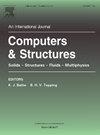Efficient parametric model order reduction in contact mechanics
IF 4.8
2区 工程技术
Q1 COMPUTER SCIENCE, INTERDISCIPLINARY APPLICATIONS
引用次数: 0
Abstract
Contact problems are inherently non-linear and present significant computational challenges in simulations. Traditional proper orthogonal decomposition-based non-linear system reduction often proves inefficient due to the complexity of handling full-scale models. This article presents a generalized parametric model order reduction framework tailored for dynamic contact problems involving arbitrarily-shaped inclusions, incorporating various specialized approaches. The proposed framework features a two-tier reduction process: the first tier applies a proper orthogonal decomposition-based model order reduction approach, while the second tier employs either the discrete empirical interpolation method or energy conserving sampling and weighting to address the reduction of non-linear terms. Discrete empirical interpolation method identifies nodes in contact as indices for the reduction of non-linear terms, and energy conserving sampling and weighting highlight contact elements as the most contributing elements to virtual work associated with non-linear forces. These results align with physics of the problem, as in this article, everything is linear except for the contact non-linearity. Two construction strategies are evaluated: one utilizing a single global basis and another using interpolated local bases. The framework leveraging local bases interpolation on the tangent space to the Grassmannian manifold demonstrates better accuracy compared to the global basis approach. The effectiveness of the different approaches within the generalized parametric model order reduction framework is evaluated through standard 2D dynamic contact problems involving perfectly bonded inclusions.
接触力学中有效的参数模型降阶
接触问题本质上是非线性的,在模拟中提出了重大的计算挑战。由于处理全尺寸模型的复杂性,传统的基于正交分解的非线性系统约简方法往往效率低下。本文提出了一个广义的参数模型降阶框架,为涉及任意形状夹杂的动态接触问题量身定制,结合各种专门方法。提出的框架具有两层约简过程:第一层采用适当的基于正交分解的模型阶数约简方法,而第二层采用离散经验插值方法或节能采样和加权来解决非线性项的约简问题。离散经验插值方法将接触节点作为非线性项约简的指标,节能采样和加权突出了接触元素作为非线性力相关虚功的最大贡献元素。这些结果与问题的物理性质一致,正如本文所述,除了接触非线性外,一切都是线性的。评估了两种构建策略:一种使用单一的全局基,另一种使用插值的局部基。与全局基方法相比,利用切线空间上的局部基插值的框架具有更好的精度。在广义参数模型降阶框架下,通过标准的二维动态接触问题评估了不同方法的有效性。
本文章由计算机程序翻译,如有差异,请以英文原文为准。
求助全文
约1分钟内获得全文
求助全文
来源期刊

Computers & Structures
工程技术-工程:土木
CiteScore
8.80
自引率
6.40%
发文量
122
审稿时长
33 days
期刊介绍:
Computers & Structures publishes advances in the development and use of computational methods for the solution of problems in engineering and the sciences. The range of appropriate contributions is wide, and includes papers on establishing appropriate mathematical models and their numerical solution in all areas of mechanics. The journal also includes articles that present a substantial review of a field in the topics of the journal.
 求助内容:
求助内容: 应助结果提醒方式:
应助结果提醒方式:


